Agathosma ciliata
Agathosma ciliata (L.) Link
Family: Rutaceae
Common names: steenbok buchu (Eng.); steenbokboegoe (Afr.)
Introduction
The steenbok buchu is a small, hardy, aromatic shrub suited to a semi-shaded, Mediterranean-climate fynbos garden, with acidic sandy soils, winter-rainfall and intermittent to no summer showers.
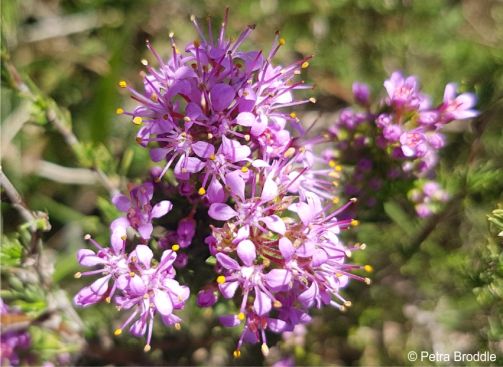
Description
Description
Agathosma ciliata is a slender, spreading, single-stemmed shrub to 600 mm tall. Twigs hairy. Leaves lance-shaped, acute, 10-17 mm long, spreading; hairless on both sides but margins are fringed with long and short hairs and the midvein has long and short hairs below. White or mauve flowers in lax, terminal clusters, are produced during winter, from autumn (April) to spring (September). Flower stalks are usually reddish. The fruits are 2-chambered capsules.
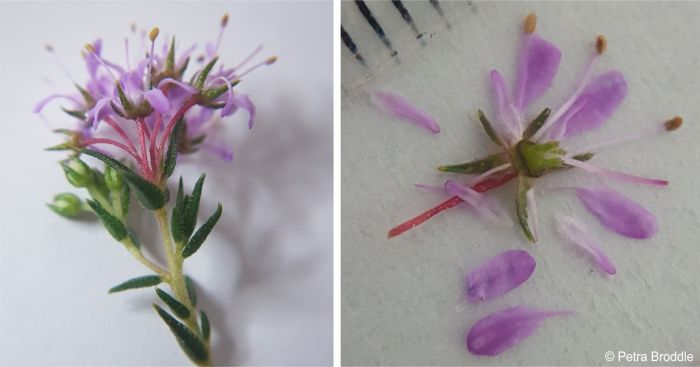
Conservation Status
Status
According the SANBI Red List of South African Plants, this montane species is not experiencing any population decline and is therefore accorded a status of Least Concern (LC).
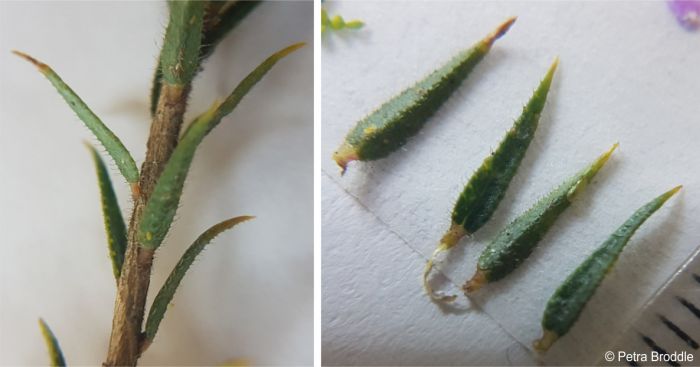
Distribution and habitat
Distribution description
This species is common on sheltered sandstone slopes from Bain’s Kloof, outside Wellington, to the Cape Peninsula, just past Cape Town.
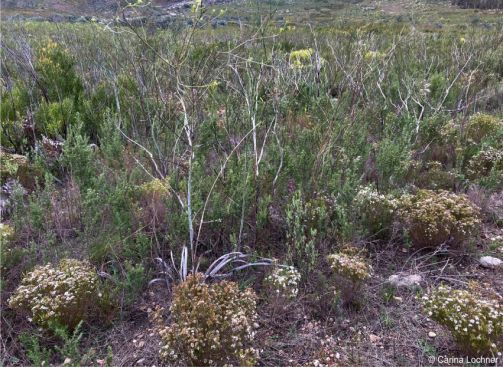
Derivation of name and historical aspects
History
The genus name Agathosma, is derived from the Greek, agathos,which means good and osme, which means smell. This refers to the fragrant oils in the glands of the leaves which is so typical of the genus and the family. The specific epithet ciliata is Latin for delicate hairs and is in reference to the recurved hairs on the margins of the leaves.
Agathosma belongs in the citrus family or Rutaceae, which is currently made up of some 160 genera and 1 650 species. Rutaceae, known for its variety of citrus fruits, plays an important economic role within agriculture and other industries. The family at large is common throughout the temperate and tropical regions of the world such as Australia or South Africa. There are about 21 genera and 301 species, which include the genera Vepris, Zanthoxylum and Calodendron, found in southern Africa. Of the 21 genera found in South Africa, 11 are endemic and do not resemble citrus fruit at all. One such genus is Agathosmawhich consists of roughly 150 species of small to large evergreen species and is mostly confined to the Western Cape. This region , home to the greatest diversity of buchu species in South Africa, includes the majority of other buchu species within genera such as Diosma, Coleonema, Acmadenia, Macrostylus and Adenandra.
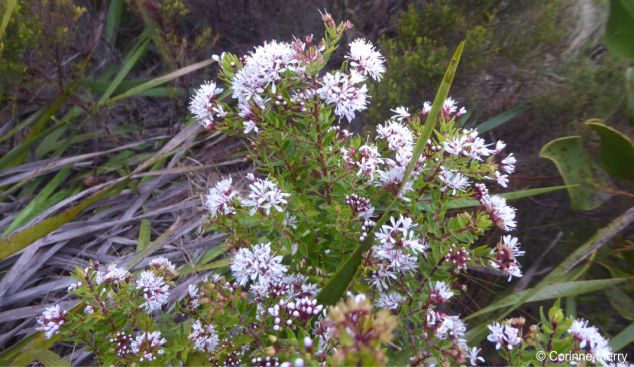
Ecology
Ecology
A feature that is synonymous with members of this family is the presence of aromatic oil glands in the leaves. This gives each species a distinctive fragrance.
The seeds of buchus are released in an very powerful manner, with a loud bang, due to the hygroscopic properties of the inner layer of the wall which cause the capsule to burst open and shoot out the seeds.
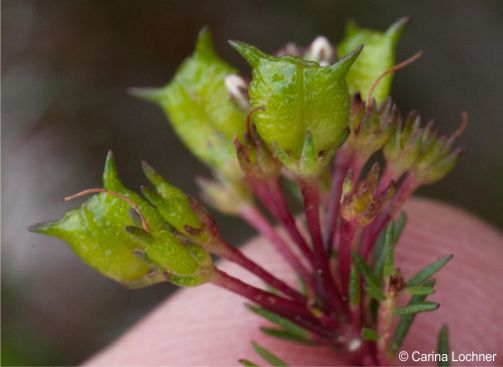
Uses
Use
No medicinal or other uses have been recorded for this species.
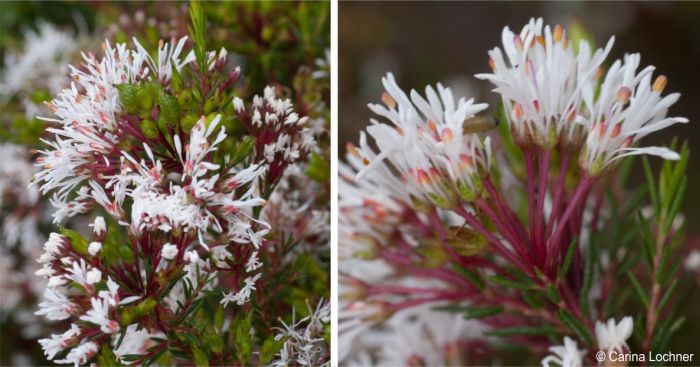
Growing Agathosma ciliata
Grow
At the Kirstenbosch NBG this species has only ever been propagated by vegetative means, through taking cuttings. Prepare cuttings between 25 and 50 mm long, taken from fresh material of the current year’s growth. Then remove about a third of the foliage and cut them below the node. Dip the cuttings in a rooting hormone and place in trays with a medium consisting of coarse river sand or equal parts bark and vermiculite. Place the cuttings in a mist-unit with heated benches. Once rooted, pot the cuttings into a well-draining potting-soil and then move them to a shady area for 2–4 weeks, to harden off. After this, plants can be moved into full sun. This will also be a good time to pinch growing tips of the seedlings to encourage a more bushy growth habit.
Should seeds become available, the same methodology could be applied as with normal fynbos-propagation where smoke-treatment of the seeds is applied. Seeds can be treated in two ways: Soak seed before sowing using the Kirstenbosch Seed Primer. The second method will see seed sown in autumn in a well-draining medium such as coarse river sand or equal parts of sand and compost in then be ‘smoke-treated’ in an enclosed space into which smoke gets pumped. Cover the seeds with a thin layer of either sand or bark, and then water. Place the seed tray in a sheltered area that provides good light and ventilation. The medium must be kept moist and never be allowed to dry out completely or be overwatered. Buchus generally take 1-2 months to germinate, and when the first 4 true leaves appear, it will be the signal that the seedlings are ready for pricking out. The fine roots are extremely fragile and must be handled with extreme care. Move potted seedlings for 3–4 weeks to a shady area to harden them off. Seedlings can then be placed in full sun.
Plant this buchu with other fynbos species, which may include: Adenandra villosa, Adenandra uniflora, Coleonema album, Protea cynaroides, Protea repens, Leucospermum cordifolium, Leucospermum prostratum, Pelargonium betulinum, Pelargonium capitatum, Pelargonium grandiflorum, Pelargonium cucullatum, Diosma hirsuta, Diosma oppositifolia, Agathosma capensis, Agathosma imbricata, Agathosma crenulata, Staberoha banksia, Elegia fistulosa, Ursinia speciosa, Dimophotheca pluvialis, Cotyledon orbiculata, Oedera imbricata, Felicia aethiopica, Felicia filifolia and Salvia aurea.
Plant this species in areas of light shade or where there is some shade for part of the day, preferably in well-drained, sandy soil. The ideal time for planting is in the rainy season between autumn and winter. This allows plants to have a better chance of establishing themselves in the garden well before they have to deal with the harsh, dry summer conditions. Plant at intervals of 200–300 mm as this usually provides enough space to encourage growth. Such relatively dense planting is preferred by buchus, as it assists with retaining soil moisture. Mulching also helps in keeping the roots and soil cool during summer.
No pests or diseases have been recorded.
References
- Broddle, P. 2022-Aug. Observation of Agathosma ciliata, Tygerberg Hills. iNaturalist. Online. https://www.inaturalist.org/observations/132039364.
- Cholo, F. 2006. Agathosma ciliata (L.) Link. National Assessment: Red List of South African Plants. https://redlist.sanbi.org/species.php?species=3359-37
- Clarke, H. & Charters, M. 2016. The illustrated dictionary of southern African plant names. Flora & Fauna Publications Trust, Jacana, Johannesburg.
- Koekemoer, M., Steyn, H.M. & Bester, S.P. 2015. Guide to Plant Families of southern Africa. Strelitzia 31. 2nd ed., 2nd print. South African National Biodiversity Institute, Pretoria, South Africa.
- Lochner, C. 2023-Sep Observation of Agathosma ciliata, Wemmershoek Dam Catchment Area. iNaturalist. Online. https://www.inaturalist.org/observations/183827545.
- Lucas, N. 2008. Agathosma capensis (L.) Dummer (Rutaceae). PlantZAfrica. Online. http://pza.sanbi.org/agathosma-capensis.
- Manning, J. & Goldblatt, P. 2012. Plants of the Greater Cape Floristic Region 1: the Core Cape Flora. Strelitzia 29. South African National Biodiversity Institute, Pretoria.
- Maytham Kidd, M. 1983. Cape Peninsula. South African Wild Flower Guide 3. Botanical Society of SA, Cape Town.
- Merry, C. 2018-Aug. Observation of Agathosma ciliata, Table Mountain near MCSA hut. iNaturalist. Online. https://www.inaturalist.org/observations/16097633.
- Oliver, R. 2016-7. Agathosma ciliaris. (L.) Druce (Rutaceae). PlantZAfrica. Online. http://pza.sanbi.org.za/agathosma-ciliaris.
- Sonder, O.W. 1860. Rutaceae. Flora Capensis 1:369-442.
- Trinder-Smith, T. 2006. Wild flowers of Table Mountain. Botanical Society of South Africa, Cape Town
Credits
Roger Oliver
Kirstenbosch National Botanical Garden
August 2025
Acknowledgements: images by Petra Broddle, Corinne Merry and Carina Lochner.
Plant Attributes:
Plant Type: Shrub
SA Distribution: Western Cape
Soil type: Sandy
Flowering season: Spring, Winter
PH: Acid
Flower colour: White, Mauve/Lilac
Aspect: Full Sun, Morning Sun (Semi Shade), Afternoon Sun (Semi Shade)
Gardening skill: Average
Special Features:
Horticultural zones
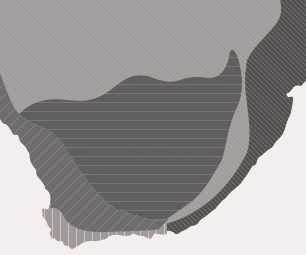







Rate this article
Article well written and informative
Rate this plant
Is this an interesting plant?
Login to add your Comment
Back to topNot registered yet? Click here to register.